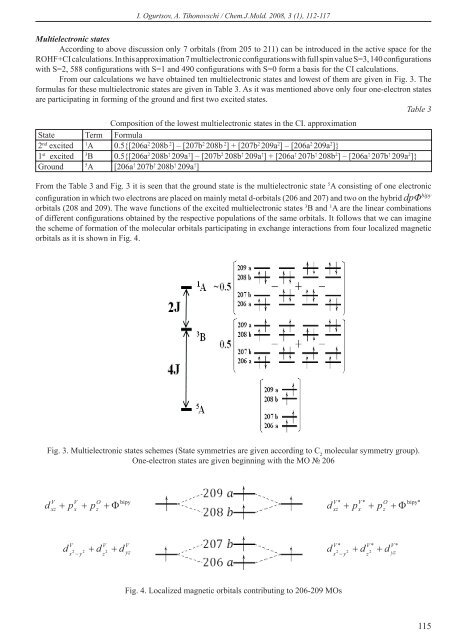chemistry journal of moldova
chemistry journal of moldova
chemistry journal of moldova
Create successful ePaper yourself
Turn your PDF publications into a flip-book with our unique Google optimized e-Paper software.
I. Ogurtsov, A. Tihonovschi / Chem.J.Mold. 2008, 3 (1), 112-117Multielectronic statesAccording to above discussion only 7 orbitals (from 205 to 211) can be introduced in the active space for theROHF+CI calculations. In this approximation 7 multielectronic configurations with full spin value S=3, 140 configurationswith S=2, 588 configurations with S=1 and 490 configurations with S=0 form a basis for the CI calculations.From our calculations we have obtained ten multielectronic states and lowest <strong>of</strong> them are given in Fig. 3. Theformulas for these multielectronic states are given in Table 3. As it was mentioned above only four one-electron statesare participating in forming <strong>of</strong> the ground and first two excited states.Table 3Composition <strong>of</strong> the lowest multielectronic states in the CI. approximationState Term Formula2 nd excited 1A 0.5{[206a 2 208b 2 ] – [207b 2 208b 2 ] + [207b 2 209a 2 ] – [206a 2 209a 2 ]}1 st excited 3B 0.5{[206a 2 208b 209a ] – [207b 2 208b 209a ] + [206a 207b 208b 2 ] – [206a 207b 209a 2 ]}Ground 5A [206a 207b 208b 209a ]From the Table 3 and Fig. 3 it is seen that the ground state is the multielectronic state 5 A consisting <strong>of</strong> one electronicconfiguration in which two electrons are placed on mainly metal d-orbitals (206 and 207) and two on the hybrid dp bipyorbitals (208 and 209). The wave functions <strong>of</strong> the excited multielectronic states 3 B and 1 A are the linear combinations<strong>of</strong> different configurations obtained by the respective populations <strong>of</strong> the same orbitals. It follows that we can imaginethe scheme <strong>of</strong> formation <strong>of</strong> the molecular orbitals participating in exchange interactions from four localized magneticorbitals as it is shown in Fig. 4.Fig. 3. Multielectronic states schemes (State symmetries are given according to C 2molecular symmetry group).One-electron states are given beginning with the MO 206dVxzpVxpOzbipy dV *xzpV *xpOz bipy*dVx y dV2z dVyz2 2dV *2x y2 dV *2z dV *yzFig. 4. Localized magnetic orbitals contributing to 206-209 MOs115
















